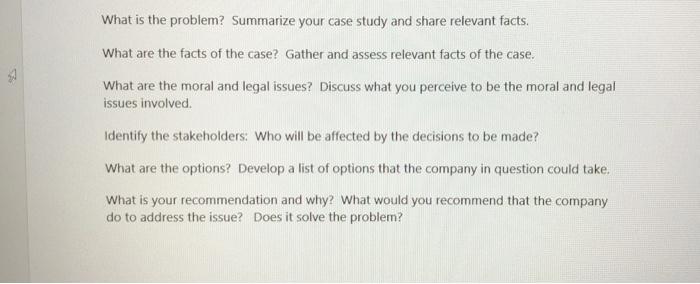Please Read the Cases before attending Business Ethics: Case 1: XYZ, Corporation is a Delaware corporation. One of its shareholders, Mr. Busybody, a U.S. citizen, while on vacation in Bangladesh, decided to check on his investment with XYZ and visit one of the many manufacturing facilities that XYZ has in Bangladesh. Mr. Busybody was shocked to discover when he entered one of the facilities that it was full of children between the ages of 6 and 8 years old. These children were sewing the garments that XYZ manufactures. It is not illegal to employ children to work in factories in Bangladesh. The children are from an orphanage and the orphanage is paid by XYZ Corporation for each child at the rate of $0.25 per hour per child. XYZ imports the garments and sells them at Walmart. XYZ issues dividends to its shareholders on a quarterly basis. XYZ has declared a dividend each quarter for the last five years. The value of Mr. Busybody's stock in XYZ has continued to increase despite the downturn in the economy. Should Mr. Busybody keep his stock in XYZ? Should he keep the stock and use his influence as a stockholder to get XYZ to hire adults at its facilities in Bangladesh? What should XYZ do? What should Walmart do? Case 2: The manufacturing cost of the widgets your company makes has dropped by 50%. One of your customers, Sam, tells you he knows this because he is best friends with your company's VP of production and asks you for a discount on his order. Your boss okays the discount. Your other customer, Sue (who is one of your best friends and knows nothing about the drop-in manufacturing costs), places the exact same order for widgets as Sam. Do you offer her a similar discount? Do you tell her about the drop-in manufacturing costs? What is the problem? Summarize your case study and share relevant facts. What are the facts of the case? Gather and assess relevant facts of the case. What are the moral and legal issues? Discuss what you perceive to be the moral and legal issues involved Identify the stakeholders: Who will be affected by the decisions to be made? What are the options? Develop a list of options that the company in question could take. What is your recommendation and why? What would you recommend that the company do to address the issue? Does it solve the problem? Please Read the Cases before attending Business Ethics: Case 1: XYZ, Corporation is a Delaware corporation. One of its shareholders, Mr. Busybody, a U.S. citizen, while on vacation in Bangladesh, decided to check on his investment with XYZ and visit one of the many manufacturing facilities that XYZ has in Bangladesh. Mr. Busybody was shocked to discover when he entered one of the facilities that it was full of children between the ages of 6 and 8 years old. These children were sewing the garments that XYZ manufactures. It is not illegal to employ children to work in factories in Bangladesh. The children are from an orphanage and the orphanage is paid by XYZ Corporation for each child at the rate of $0.25 per hour per child. XYZ imports the garments and sells them at Walmart. XYZ issues dividends to its shareholders on a quarterly basis. XYZ has declared a dividend each quarter for the last five years. The value of Mr. Busybody's stock in XYZ has continued to increase despite the downturn in the economy. Should Mr. Busybody keep his stock in XYZ? Should he keep the stock and use his influence as a stockholder to get XYZ to hire adults at its facilities in Bangladesh? What should XYZ do? What should Walmart do? Case 2: The manufacturing cost of the widgets your company makes has dropped by 50%. One of your customers, Sam, tells you he knows this because he is best friends with your company's VP of production and asks you for a discount on his order. Your boss okays the discount. Your other customer, Sue (who is one of your best friends and knows nothing about the drop-in manufacturing costs), places the exact same order for widgets as Sam. Do you offer her a similar discount? Do you tell her about the drop-in manufacturing costs? What is the problem? Summarize your case study and share relevant facts. What are the facts of the case? Gather and assess relevant facts of the case. What are the moral and legal issues? Discuss what you perceive to be the moral and legal issues involved Identify the stakeholders: Who will be affected by the decisions to be made? What are the options? Develop a list of options that the company in question could take. What is your recommendation and why? What would you recommend that the company do to address the issue? Does it solve the








